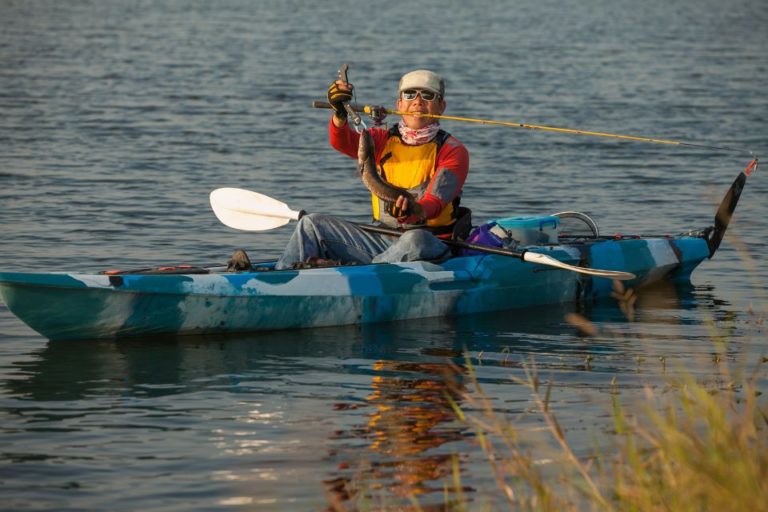The Ultimate Guide to Choosing the Perfect Fishing Kayak
Choosing the right kayak for fishing can greatly impact your overall fishing experience. With so many options available, it can be overwhelming to make a decision.
In this comprehensive buying guide, I will walk you through the key factors to consider when selecting the perfect fishing kayak.
Whether you’re a beginner or a seasoned angler, this guide will help you make an informed decision and find the ideal kayak for your fishing needs.
Understanding Your Fishing Needs
When it comes to choosing the right kayak for fishing, understanding your fishing needs is important. Let’s delve into the key aspects to consider.
» Types of Fishing
Are you into freshwater or saltwater fishing?
Each type of fishing may require specific features in a kayak. For example, saltwater fishing may necessitate a more stable and durable kayak due to potentially rougher waters.
» Fishing Location
Consider where you will predominantly be fishing. Will it be in calm inland waters, or are you planning on braving the open sea?
Different locations may demand different kayak designs and features to ensure an enjoyable and safe fishing experience.
» Storage and Transportation Considerations
Reflect on how you plan to store and transport your kayak. Do you have ample storage space or will you need a kayak that is more compact and easy to transport?
Additionally, consider the weight of the kayak and whether you will need assistance in transporting it to and from the water.
Kayak Type
When delving into the world of kayak fishing, one of the initial decisions to make is selecting the right kayak type for your angling endeavors.
Understanding the fundamental differences between sit-on-top and sit-inside kayaks, along with the impact of length and width on performance, will help you make an informed choice.
» Sit-On-Top vs. Sit-Inside
Sit-on-top kayaks offer a more open and spacious design, making them suitable for anglers who prefer easy entry and exit.
These kayaks are self-bailing, providing a more carefree experience. On the other hand, sit-inside kayaks offer better protection from the elements and are generally favored in colder climates.
» Length and Width
The length and width of a kayak greatly influence its performance on the water. Longer kayaks provide better tracking and higher speed, while shorter kayaks are more maneuverable in tight spaces.
Additionally, the width of a kayak affects its stability, with wider kayaks offering more stability but sacrificing speed.
» Stability and Maneuverability
Stability is a crucial factor to consider when choosing a fishing kayak, as it impacts your comfort and confidence while casting and reeling in fish.
On the other hand, maneuverability plays a key role in navigating through different water conditions and reaching prime fishing spots. Finding the right balance between stability and maneuverability is essential for an enjoyable fishing experience.
Fishing Kayak Features
When it comes to choosing the right fishing kayak, it’s essential to consider various features that can make your fishing experience more enjoyable and efficient.
From comfortable seating to versatile storage options and customizable features, the right fishing kayak should be equipped to meet your specific angling needs.
» Seating and Comfort
The seating and comfort of a fishing kayak are crucial for long hours on the water. Look for kayaks with adjustable and supportive seats to ensure proper posture and reduced fatigue.
Consider investing in a kayak with an ergonomic design and ample cushioning to enhance your overall comfort during extended fishing trips.
» Storage Options
Efficient storage options are essential for stowing away fishing gear, tackle boxes, and personal belongings.
Look for kayaks equipped with spacious hatches, secured compartments, and bungee cords to keep your essentials organized and easily accessible.
Ample storage capacity ensures that you can bring along all the necessary equipment without feeling cramped or cluttered.
» Rod Holders and Mounting Options
Having dedicated rod holders and mounting options on your fishing kayak can significantly enhance your angling experience.
Look for kayaks with integrated rod holders and versatile mounting systems for additional accessories such as fish finders, GPS devices, or camera mounts.
These features allow you to keep your hands free while keeping your fishing gear within reach.
» Customization Potential
A fishing kayak with high customization potential allows you to personalize your angling setup according to your preferences.
Look for kayaks with modular accessory tracks, adjustable mounting points, and compatibility with aftermarket upgrades. This flexibility enables you to tailor your kayak to suit different fishing techniques and adapt to varying water conditions.
By considering these key features in a fishing kayak, you can make an informed decision that aligns with your angling style and preferences, ultimately enhancing your fishing adventures on the water.

Material and Weight
Choosing the right kayak for fishing involves considering the material and weight of the kayak. The material of the kayak affects its durability, while the weight determines the kayak’s capacity and ease of transportation.
» Material Durability
Kayaks are commonly made from a variety of materials, including plastic, fiberglass, and composite. Plastic kayaks, such as those made from polyethylene, are durable and can withstand impacts from rocks and other obstacles in the water.
Fiberglass kayaks are lightweight and offer excellent performance, but they may be more prone to damage from collisions.
Composite kayaks, made from materials like Kevlar or carbon fiber, provide a balance of durability and weight, ideal for avid anglers who want a high-performance kayak that can handle rugged conditions.
» Weight Capacity
The weight capacity of a kayak is a crucial consideration for fishermen. It determines the maximum load the kayak can carry while remaining stable and maneuverable.
Factors such as the angler’s body weight, fishing gear, and additional accessories should be taken into account when assessing the kayak’s weight capacity.
Opting for a kayak with a higher weight capacity ensures that there is sufficient room for gear and catch without compromising stability.
» Weight for Transportation
The weight of the kayak plays a significant role in its transportability. Heavier kayaks may require additional assistance or specialized equipment for transport, while lighter kayaks can be easily lifted onto roof racks or carried short distances.
For anglers who often fish in remote or off-the-grid locations, a kayak that is lightweight and portable can be a valuable asset, simplifying the process of getting the kayak to and from the water.
Finding the right balance between weight and durability is essential for a kayak that can withstand the rigors of fishing expeditions while remaining manageable for transportation.
Propulsion
When choosing a fishing kayak, considering the propulsion system is crucial. The choice between paddle and pedal-driven kayaks, as well as motorized options, can greatly impact your fishing experience.
» Paddle vs. Pedal-Driven
Paddle kayaks provide a traditional and serene method of propulsion. They offer a great workout and precise maneuvering in shallow waters.
On the other hand, pedal-driven kayaks, equipped with systems like pedal-operated flippers, allow for hands-free fishing and easier navigation.
Consider the type of fishing environment and your preference for physical effort when deciding between these two options.
» Motorized Options
For anglers seeking efficiency and longer excursions, motorized kayaks can be an appealing choice. Electric trolling motors or gas-powered outboard motors offer advantages in covering larger distances and combating strong currents.
However, it’s important to be mindful of the regulations and restrictions in your fishing area regarding using motorized kayaks.
Additional Considerations
When choosing the right kayak for fishing, there are some additional factors to consider beyond the basic features.
These include the price and your budget, the reputation of the brand and manufacturer, as well as user reviews and recommendations.
» Price and Budget
The price of a fishing kayak can vary widely depending on the features, materials, and brand. It’s essential to set a budget and stick to it, but also be willing to invest in a quality kayak that meets your specific fishing needs.
Consider the long-term value and durability of the kayak concerning the initial cost.
» Brand and Manufacturer Reputation
Researching the reputation of the brand and manufacturer is crucial when making a purchasing decision. Established brands with a history of producing reliable and high-quality kayaks may provide more peace of mind.
Look for brands known for their craftsmanship, customer service, and warranty offerings.
» User Reviews and Recommendations
Reading user reviews and seeking recommendations from fellow anglers can provide valuable insights into the performance and reliability of a specific kayak model.
Pay attention to common themes or recurring praise and concerns in the reviews, as they can offer a realistic perspective on the kayak’s strengths and weaknesses.
Conclusion
Choosing the right kayak for fishing is crucial for a successful and enjoyable fishing experience.
By considering factors such as kayak type, stability, storage, and accessories, you can make an informed decision that aligns with your specific needs and preferences.
Remember to prioritize safety and comfort, and don’t hesitate to test out different kayaks before making a purchase. With the right kayak, you can look forward to many memorable fishing adventures on the water.



